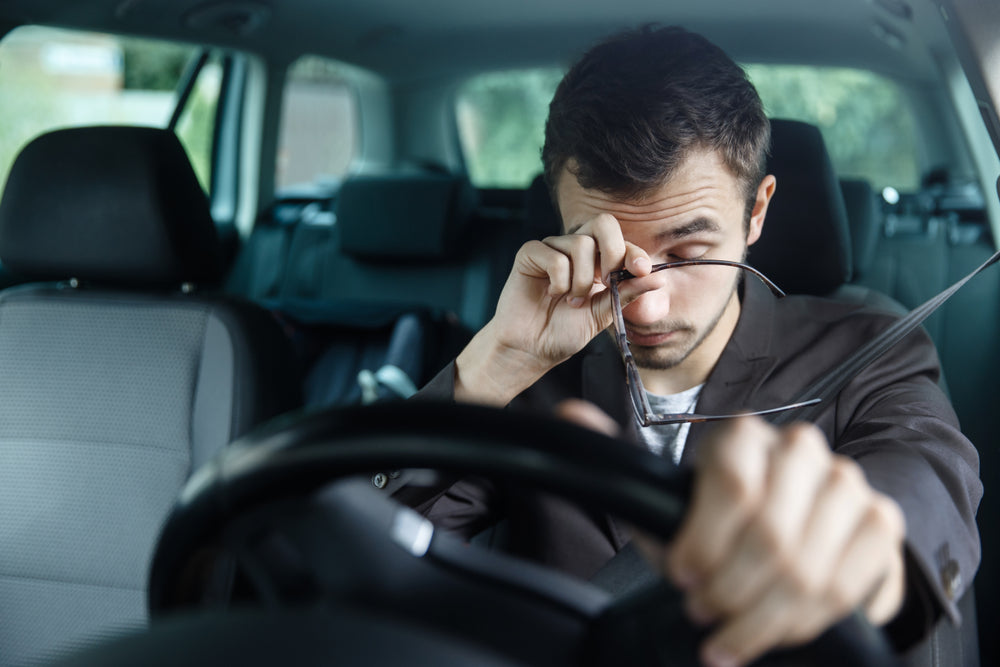Driving is an inherently dangerous activity—that much we all know. Being alert and aware on the roads is a crucial part of being a safe and responsible driver. An estimated 1 in 25 drivers over the age of 18 have reported having fallen asleep while driving in the last 30 days alone, and The National Highway Traffic Safety Administration estimates that drowsy driving is responsible for up to 6,000 fatal crashes each year. While getting behind the wheel may be dangerous after a night of bad sleep, it’s very possible you may be driving drowsy even if you think you got a full 8 hours last night.
Top 3 Risks
One of the leading causes of excessive daytime drowsiness is Obstructive Sleep Apnea (OSA). However, it is estimated that about 80% of OSA cases go undiagnosed, so sufferers may be unaware that their fatigue is the result of a very treatable condition. In fact, the results of a recent study found that patients with sleep apnea were almost 2.5X more likely to be the driver in a car accident when compared with a control group of drivers in the normal population. Luckily sleep apnea is a very manageable disorder when paired with continuous positive airway pressure (CPAP) or Automatic positive airway pressure (AutoPAP) treatment. When untreated you could be the victim of these extreme driving risks:
- Decreased Focused on the Road
- Slowed Reaction Time
- Poor Decision Making Skills
All three of these very real risks threaten you on the road when you choose to drive drowsy. Sleepiness impacts your necessary focus on the road in front of you. You will be unable to properly gauge the behaviors of the cars in front of and behind you, less aware of your surroundings (i.e. pedestrians), and more easily distracted by your radio or even your own thoughts.
Secondly, slowed reaction times very much increase the likelihood of an accident because driving requires you to be prepared for the unexpected. If you are driving in a residential area, reaction time allows you to quickly avoid tragedies, like hitting children or animals who have run into the road. Reaction time also gives you a leg up in preventing accidents with other cars on the road who may also be reacting to unanticipated events. If cars slam on their brakes in response to an event, you need to be prepared to react quickly, thereby avoiding a secondary accident for which you would be at fault.
All of these risks can be summed up by the ultimate risk of exercising poor decision making skills on the road—as well as poor decisions made before getting behind the wheel.
"This study provides very strong evidence that obstructive sleep apnea patients have an increased traffic accident risk and that this risk can be modified if CPAP treatment is used adequately," said principal investigator and senior author Dr. Ludger Grote, associate professor at the Center for Sleep and Vigilance Disorders at the Sahlgrenska Academy at the University of Gothenburg in Sweden.
Risks to CDL Drivers
While the effects of drowsy driving are a serious danger for the average driver, these risks are amplified for truckers and other CDL drivers—like tow trucks, tractor trailers, and buses—who are responsible for hauling large vehicles across the highway. It’s been proven that truckers are at an increased risk for sleep apnea, and the nature of their work makes getting good quality sleep a necessity for their own safety and the safety of others on the road. This is especially poignant because truckers are frequently behind the wheel for very long periods of time during the day and night.
Trucking companies should be sure that their CDL employees undergo regular medical examinations, including home sleep studies if there is any potential risk for untreated disorders, like sleep apnea, that can impair their ability to safely drive.
Signs of Drowsiness
When you’re getting ready to drive, or perhaps even already on the road, you need to be aware of these tell tale signs of fatigue and drowsiness:
- Yawning and/or blinking frequently
- Difficulty remembering or recalling the last few miles of driving
- Missing an exit
- Drifting in and out of your lane
- Hitting a rumble strip on the roadside
If you notice yourself exhibiting any of these signs, it is imperative that you exit the road as soon as possible. If necessary, you should pull off to the side and sleep for a bit until you are rested enough to resume driving safely.
Checking for Sleep Apnea
Of course, all the risks of drowsy and fatigued driving are curable. No one needs to put themselves and others at risk so long as they can secure the appropriate treatments that lead to restorative sleep. If you believe that you may be at risk for sleep apnea, you need to undergo a sleep study to get the answers you need. Home sleep tests are a great option for those who believe they suffer from this disorder because they allow you to get quick, effective answers from the comfort of home without the hefty in-lab sleep study price tag. Sleep apnea is a very treatable condition but it does require a prescription. Making the roads safer is a goal we can all agree on, so do away with the risks of fatigued driving and start getting the high-quality sleep we all need to be healthy.

